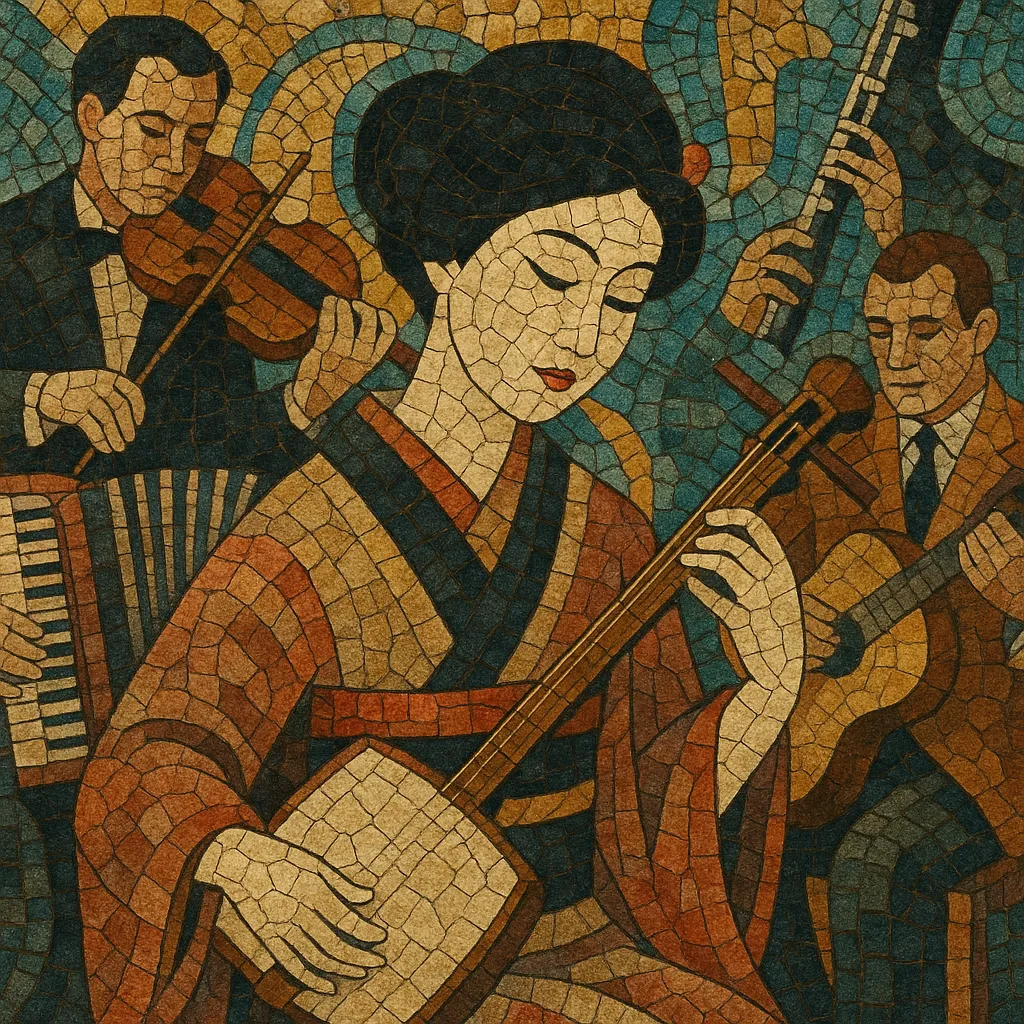Ryūkōka is an early form of Japanese popular song that blossomed from the late Taishō into the early Shōwa era. It blends Western popular idioms—such as waltz, tango, foxtrot, and jazz—with Japanese pentatonic melodies and vocal ornamentation.
Characterized by crooning vocals, sentimental themes, and orchestrations that could include strings, guitar, accordion, clarinet, and sometimes shamisen, ryūkōka provided the blueprint for later Japanese popular styles. Its melodies often use the yo and in pentatonic scales, while harmonies draw from Western tonality, resulting in a distinctive fusion of local melody and imported harmony.
The genre documented urban modernity, romance, wartime experience, and nostalgia, becoming the sound of a rapidly changing Japan between the 1920s and 1950s.
Ryūkōka emerged as the gramophone record industry took root in Japan, with labels like Victor and Columbia cultivating a market for domestically produced “popular songs.” Early writers adapted Western dance rhythms and harmonies to Japanese melodic sensibilities, while trained singers brought art-song poise to popular material. The result was a new hybrid idiom that sounded modern yet recognizably Japanese.
During the early Shōwa era, ryūkōka became a national soundtrack. Composers such as Masao Koga, Shinpei Nakayama, and Ryōichi Hattori crafted songs that mixed waltz, tango, foxtrot, and light jazz with pentatonic melodies and vocal turns (kobushi). Star vocalists—crooners and divas alike—popularized an intimate, microphone-based delivery that contrasted with traditional projection, while lyrics captured city life, romance, and bittersweet nostalgia.
As Japan entered wartime, censorship and propaganda redirected popular song towards morale-boosting and patriotic themes. While the stylistic core of ryūkōka persisted, subject matter narrowed, and marching rhythms and anthemic contours became more common. Nevertheless, the crooning timbre and hybrid orchestration remained recognizable.
After 1945, American jazz, boogie-woogie, and new dance crazes reinvigorated popular music. Figures like Shizuko Kasagi led a buoyant, jazz-inflected wave, while younger stars (including a youthful Hibari Misora) bridged older ryūkōka sentiment with emerging styles. By the late 1950s, the umbrella term kayōkyoku came to dominate, and a strand of sentimental ryūkōka crystalized into what would later be called “modern” enka.
Ryūkōka provided the foundational vocabulary for Japanese popular song: microphone crooning, Western harmonies supporting Japanese melodic shapes, and sophisticated orchestration. It directly seeded kayōkyoku and modern enka, and—through them—shaped the trajectory of J‑pop and Japanese idol music.
Use Japanese pentatonic scales (yo and in) for primary melodic material. Craft singable, arching lines that favor stepwise motion and occasional ornamental turns (kobushi). Aim for a crooning, intimate vocal line that sits comfortably in a mid-range.
Support melodies with Western functional harmony (I–IV–V with tasteful secondary dominants). For tango-tinged pieces, employ minor keys, chromatic passing chords, and cadence figures typical of early 20th‑century popular song. Favor strophic or verse–refrain forms with a short instrumental intro and interlude.
Draw on waltz (3/4), tango (4/4 with habanera-like syncopation), foxtrot (medium 4/4), and gentle march feels. Keep tempos moderate (about 60–110 BPM) to highlight lyric delivery and melody.
Combine small orchestra colors—strings, woodwinds (clarinet), muted brass, accordion, and acoustic guitar—with occasional shamisen for local color. Use intro fanfares, brief modulations, and melodic countermelodies in strings or clarinet to frame the vocal. Keep textures transparent so the singer remains central.
Adopt a smooth, close‑miked croon with restrained vibrato and subtle melisma. Write lyrics that evoke urban scenes, seasons, bittersweet romance, and nostalgia; imagery and emotional nuance are more important than plot. Rhyme can be flexible; prioritize natural prosody.
Emulate mono-era aesthetics: a single ribbon-style mic feel, modest room ambience, and gentle tape or tube coloration. Arrange dynamic arcs (intro–verse–interlude–final refrain) that culminate in an emotionally heightened last chorus.


